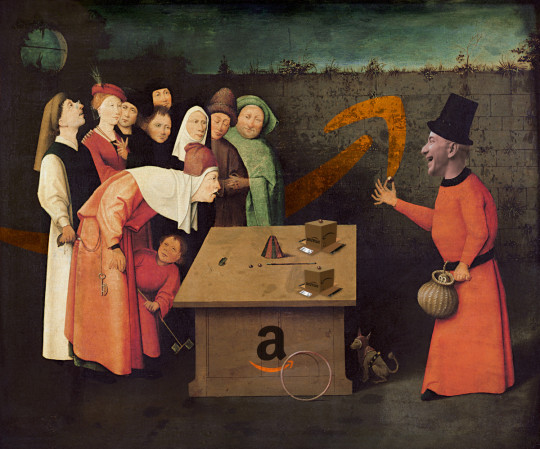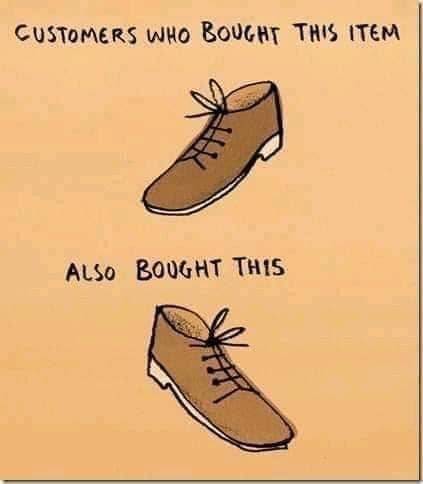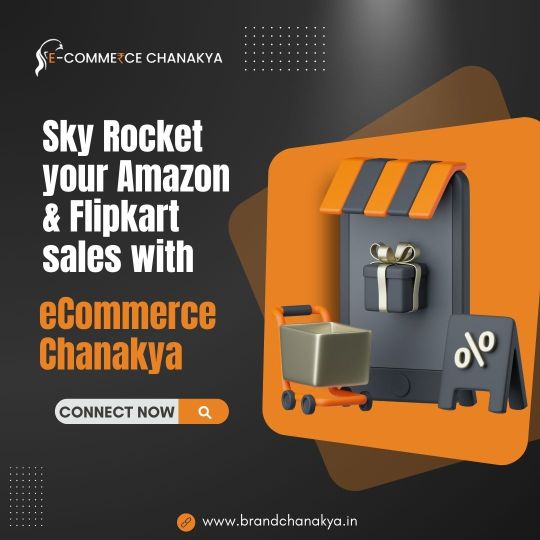#ecommerce with amazon
Text
Amazon’s financial shell game let it create an “impossible” monopoly

I'm on tour with my new, nationally bestselling novel The Bezzle! Catch me in TUCSON (Mar 9-10), then San Francisco (Mar 13), Anaheim, and more!

For the pro-monopoly crowd that absolutely dominated antitrust law from the Carter administration until 2020, Amazon presents a genuinely puzzling paradox: the company's monopoly power was never supposed to emerge, and if it did, it should have crumbled immediately.
Pro-monopoly economists embody Ely Devons's famous aphorism that "If economists wished to study the horse, they wouldn’t go and look at horses. They’d sit in their studies and say to themselves, ‘What would I do if I were a horse?’":
https://pluralistic.net/2022/10/27/economism/#what-would-i-do-if-i-were-a-horse
Rather than using the way the world actually works as their starting point for how to think about it, they build elaborate models out of abstract principles like "rational actors." The resulting mathematical models are so abstractly elegant that it's easy to forget that they're just imaginative exercises, disconnected from reality:
https://pluralistic.net/2023/04/03/all-models-are-wrong/#some-are-useful
These models predicted that it would be impossible for Amazon to attain monopoly power. Even if they became a monopoly – in the sense of dominating sales of various kinds of goods – the company still wouldn't get monopoly power.
For example, if Amazon tried to take over a category by selling goods below cost ("predatory pricing"), then rivals could just wait until the company got tired of losing money and put prices back up, and then those rivals could go back to competing. And if Amazon tried to keep the loss-leader going indefinitely by "cross-subsidizing" the losses with high-margin profits from some other part of its business, rivals could sell those high margin goods at a lower margin, which would lure away Amazon customers and cut the supply lines for the price war it was fighting with its discounted products.
That's what the model predicted, but it's not what happened in the real world. In the real world, Amazon was able use its access to the capital markets to embark on scorched-earth predatory pricing campaigns. When diapers.com refused to sell out to Amazon, the company casually committed $100m to selling diapers below cost. Diapers.com went bust, Amazon bought it for pennies on the dollar and shut it down:
https://www.theverge.com/2019/5/13/18563379/amazon-predatory-pricing-antitrust-law
Investors got the message: don't compete with Amazon. They can remain predatory longer than you can remain solvent.
Now, not everyone shared the antitrust establishment's confidence that Amazon couldn't create a durable monopoly with market power. In 2017, Lina Khan – then a third year law student – published "Amazon's Antitrust Paradox," a landmark paper arguing that Amazon had all the tools it needed to amass monopoly power:
https://www.yalelawjournal.org/note/amazons-antitrust-paradox
Today, Khan is chair of the FTC, and has brought a case against Amazon that builds on some of the theories from that paper. One outcome of that suit is an unprecedented look at Amazon's internal operations. But, as the Institute for Local Self-Reliance's Stacy Mitchell describes in a piece for The Atlantic, key pieces of information have been totally redacted in the court exhibits:
https://www.theatlantic.com/ideas/archive/2024/02/amazon-profits-antitrust-ftc/677580/
The most important missing datum: how much money Amazon makes from each of its lines of business. Amazon's own story is that it basically breaks even on its retail operation, and keeps the whole business afloat with profits from its AWS cloud computing division. This is an important narrative, because if it's true, then Amazon can't be forcing up retail prices, which is the crux of the FTC's case against the company.
Here's what we know for sure about Amazon's retail business. First: merchants can't live without Amazon. The majority of US households have Prime, and 90% of Prime households start their ecommerce searches on Amazon; if they find what they're looking for, they buy it and stop. Thus, merchants who don't sell on Amazon just don't sell. This is called "monopsony power" and it's a lot easier to maintain than monopoly power. For most manufacturers, a 10% overnight drop in sales is a catastrophe, so a retailer that commands even a 10% market-share can extract huge concessions from its suppliers. Amazon's share of most categories of goods is a lot higher than 10%!
What kind of monopsony power does Amazon wield? Well, for one thing, it is able to levy a huge tax on its sellers. Add up all the junk-fees Amazon charges its platform sellers and it comes out to 45-51%:
https://pluralistic.net/2023/04/25/greedflation/#commissar-bezos
Competitive businesses just don't have 45% margins! No one can afford to kick that much back to Amazon. What is a merchant to do? Sell on Amazon and you lose money on every sale. Don't sell on Amazon and you don't get any business.
The only answer: raise prices on Amazon. After all, Prime customers – the majority of Amazon's retail business – don't shop for competitive prices. If Amazon wants a 45% vig, you can raise your Amazon prices by a third and just about break even.
But Amazon is wise to that: they have a "most favored nation" rule that punishes suppliers who sell goods more cheaply in rival stores, or even on their own site. The punishments vary, from banishing your products to page ten million of search-results to simply kicking you off the platform. With publishers, Amazon reserves the right to lower the prices they set when listing their books, to match the lowest price on the web, and paying publishers less for each sale.
That means that suppliers who sell on Amazon (which is anyone who wants to stay in business) have to dramatically hike their prices on Amazon, and when they do, they also have to hike their prices everywhere else (no wonder Prime customers don't bother to search elsewhere for a better deal!).
Now, Amazon says this is all wrong. That 45-51% vig they claim from business customers is barely enough to break even. The company's profits – they insist – come from selling AWS cloud service. The retail operation is just a public service they provide to us with cross-subsidy from those fat AWS margins.
This is a hell of a claim. Last year, Amazon raked in $130 billion in seller fees. In other words: they booked more revenue from junk fees than Bank of America made through its whole operation. Amazon's junk fees add up to more than all of Meta's revenues:
https://s2.q4cdn.com/299287126/files/doc_financials/2023/q4/AMZN-Q4-2023-Earnings-Release.pdf
Amazon claims that none of this is profit – it's just covering their operating expenses. According to Amazon, its non-AWS units combined have a one percent profit margin.
Now, this is an eye-popping claim indeed. Amazon is a public company, which means that it has to make thorough quarterly and annual financial disclosures breaking down its profit and loss. You'd think that somewhere in those disclosures, we'd find some details.
You'd think so, but you'd be wrong. Amazon's disclosures do not break out profits and losses by segment. SEC rules actually require the company to make these per-segment disclosures:
https://scholarship.law.stjohns.edu/cgi/viewcontent.cgi?article=3524&context=lawreview#:~:text=If%20a%20company%20has%20more,income%20taxes%20and%20extraordinary%20items.
That rule was enacted in 1966, out of concern that companies could use cross-subsidies to fund predatory pricing and other anticompetitive practices. But over the years, the SEC just…stopped enforcing the rule. Companies have "near total managerial discretion" to lump business units together and group their profits and losses in bloated, undifferentiated balance-sheet items:
https://www.ucl.ac.uk/bartlett/public-purpose/publications/2021/dec/crouching-tiger-hidden-dragons
As Mitchell points you, it's not just Amazon that flouts this rule. We don't know how much money Google makes on Youtube, or how much Apple makes from the App Store (Apple told a federal judge that this number doesn't exist). Warren Buffett – with significant interest in hundreds of companies across dozens of markets – only breaks out seven segments of profit-and-loss for Berkshire Hathaway.
Recall that there is one category of data from the FTC's antitrust case against Amazon that has been completely redacted. One guess which category that is! Yup, the profit-and-loss for its retail operation and other lines of business.
These redactions are the judge's fault, but the real fault lies with the SEC. Amazon is a public company. In exchange for access to the capital markets, it owes the public certain disclosures, which are set out in the SEC's rulebook. The SEC lets Amazon – and other gigantic companies – get away with a degree of secrecy that should disqualify it from offering stock to the public. As Mitchell says, SEC chairman Gary Gensler should adopt "new rules that more concretely define what qualifies as a segment and remove the discretion given to executives."
Amazon is the poster-child for monopoly run amok. As Yanis Varoufakis writes in Technofeudalism, Amazon has actually become a post-capitalist enterprise. Amazon doesn't make profits (money derived from selling goods); it makes rents (money charged to people who are seeking to make a profit):
https://pluralistic.net/2023/09/28/cloudalists/#cloud-capital
Profits are the defining characteristic of a capitalist economy; rents are the defining characteristic of feudalism. Amazon looks like a bazaar where thousands of merchants offer goods for sale to the public, but look harder and you discover that all those stallholders are totally controlled by Amazon. Amazon decides what goods they can sell, how much they cost, and whether a customer ever sees them. And then Amazon takes $0.45-51 out of every dollar. Amazon's "marketplace" isn't like a flea market, it's more like the interconnected shops on Disneyland's Main Street, USA: the sign over the door might say "20th Century Music Company" or "Emporium," but they're all just one store, run by one company.
And because Amazon has so much control over its sellers, it is able to exercise power over its buyers. Amazon's search results push down the best deals on the platform and promote results from more expensive, lower-quality items whose sellers have paid a fortune for an "ad" (not really an ad, but rather the top spot in search listings):
https://pluralistic.net/2023/11/29/aethelred-the-unready/#not-one-penny-for-tribute
This is "Amazon's pricing paradox." Amazon can claim that it offers low-priced, high-quality goods on the platform, but it makes $38b/year pushing those good deals way, way down in its search results. The top result for your Amazon search averages 29% more expensive than the best deal Amazon offers. Buy something from those first four spots and you'll pay a 25% premium. On average, you need to pick the seventeenth item on the search results page to get the best deal:
https://scholarship.law.bu.edu/faculty_scholarship/3645/
For 40 years, pro-monopoly economists claimed that it would be impossible for Amazon to attain monopoly power over buyers and sellers. Today, Amazon exercises that power so thoroughly that its junk-fee revenues alone exceed the total revenues of Bank of America. Amazon's story – that these fees barely stretch to covering its costs – assumes a nearly inconceivable level of credulity in its audience. Regrettably – for the human race – there is a cohort of senior, highly respected economists who possess this degree of credulity and more.
Of course, there's an easy way to settle the argument: Amazon could just comply with SEC regs and break out its P&L for its e-commerce operation. I assure you, they're not hiding this data because they think you'll be pleasantly surprised when they do and they don't want to spoil the moment.

If you'd like an essay-formatted version of this post to read or share, here's a link to it on pluralistic.net, my surveillance-free, ad-free, tracker-free blog:
https://pluralistic.net/2024/03/01/managerial-discretion/#junk-fees

Image:
Doc Searls (modified)
https://www.flickr.com/photos/docsearls/4863121221/
CC BY 2.0
https://creativecommons.org/licenses/by/2.0/
#pluralistic#amazon#ilsr#institute for local self-reliance#amazon's antitrust paradox#antitrust#trustbusting#ftc#lina khan#aws#cross-subsidization#stacy mitchell#junk fees#most favored nation#sec#securities and exchange commission#segmenting#managerial discretion#ecommerce#technofeudalism
606 notes
·
View notes
Text
You don’t “try to start a business” you give it your all or nothing. Businesses don’t fail. People fail their businesses.
#self made#billionairequotes#ecommerce#make money from home#make money online#business mindset#dropshipping#quotes#success#amazon#entreprenuership#business tools#entrepreneur#millionaire mindset#mindset#start a business#successquotes#branding#new business#e-commerce#startup
500 notes
·
View notes
Text
*Inspiring Insight from Jeff Bezos**: The Power of Creativity and Boldness in Shaping the Future 🌟"
#quotes#quoteoftheday#life qoute#business#business growth#jeff bezos#success#successful#ecommerce#succession#make money online#artificial intelligence#branding#learning#course#personal development#academia#amazon#dropshipping#marketing#beautiful quote
3 notes
·
View notes
Text

Starting an e-commerce business can be an exciting venture with immense potential. However, with the opportunities come challenges and uncertainties. Before diving into the world of online retail, it’s crucial to plan carefully and set a solid foundation. Here are some essential tips to consider before launching your e-commerce business:
1. Conduct Market Research
Understanding the market is fundamental to any successful business. Start by identifying your target audience and analyzing competitors. Research trends, customer preferences, and potential gaps in the market. Tools like Google Trends, social media analytics, and industry reports can provide valuable insights. This research will help you tailor your products or services to meet market demands and differentiate yourself from competitors.
2. Define Your Business Model
E-commerce offers various business models, such as B2C (Business to Consumer), B2B (Business to Business), C2C (Consumer to Consumer), and subscription-based models. Determine which model aligns with your goals and resources. Each model has its own set of challenges and requirements, so choose one that best fits your product or service and target market.
3. Create a Solid Business Plan
A comprehensive business plan serves as a roadmap for your e-commerce venture. Outline your business goals, strategies, target audience, marketing plan, financial projections, and operational plan. This document will not only guide your efforts but also help secure funding if needed. A clear plan can keep you focused and organized as you navigate the complexities of launching and running an e-commerce business.
4. Choose the Right E-Commerce Platform
Selecting the right e-commerce platform is crucial for the success of your online store. Popular platforms like Shopify, WooCommerce, Magento, and BigCommerce each offer unique features and capabilities. Consider factors such as ease of use, scalability, customization options, payment gateways, and integration with other tools. The platform should align with your business needs and provide a user-friendly experience for both you and your customers.
5. Develop a User-Friendly Website
Your website is the face of your e-commerce business. Ensure it’s designed to be user-friendly, visually appealing, and optimized for mobile devices. A clean, intuitive layout with easy navigation will enhance the shopping experience and reduce cart abandonment rates. Focus on high-quality images, detailed product descriptions, and a seamless checkout process. Additionally, implement search engine optimization (SEO) strategies to improve your site’s visibility in search engines.
6. Implement Secure Payment Processing
Security is a top priority in e-commerce. Customers need to trust that their payment information is safe. Choose a reputable payment gateway and ensure your website uses SSL certificates to encrypt data. Additionally, offer multiple payment options, including credit/debit cards, digital wallets, and other payment methods that are popular with your target audience.
7. Plan Your Logistics and Supply Chain
Efficient logistics and supply chain management are vital for e-commerce success. Develop a strategy for inventory management, warehousing, and shipping. Decide whether you’ll handle fulfillment in-house or partner with third-party logistics providers. Consider shipping options, delivery times, and costs. A smooth and reliable fulfillment process can significantly impact customer satisfaction and repeat business.
8. Craft a Marketing Strategy
Effective marketing is essential to drive traffic and sales to your e-commerce store. Develop a multi-channel marketing strategy that includes social media, email marketing, content marketing, and paid advertising. Create engaging content, run promotions, and leverage social media platforms to build brand awareness and attract customers. Monitor and analyze the performance of your marketing efforts to refine your strategies over time.
9. Focus on Customer Service
Exceptional customer service can set your e-commerce business apart from competitors. Provide multiple channels for customer support, such as live chat, email, and phone. Ensure timely responses to inquiries and resolve issues promptly. Building strong customer relationships and encouraging feedback can enhance customer loyalty and drive positive reviews.
10. Monitor and Adapt
The e-commerce landscape is constantly evolving. Regularly review your business performance, track key metrics, and gather customer feedback. Stay informed about industry trends and technological advancements. Be prepared to adapt your strategies and operations based on insights and changes in the market.
#ecommerce#marketing#business#digitalmarketing#ecommercebusiness#entrepreneur#onlineshopping#website#seo#webdesign#b#marketingdigital#onlinebusiness#branding#shopify#smallbusiness#socialmediamarketing#webdevelopment#online#amazon#shopping#onlinestore#onlineshop#design#ecommercewebsite#dropshipping
4 notes
·
View notes
Text

Are you busy mother looking for a #BabyCarrier bag?
Baby Carrier Cum Kangaroo Bag, Baby Carry Sling, Back, Front Carrier for Baby with Safety Belt and Buckle.
Using a baby carrier has lots of benefits for babies and parents. For the parents, it means they can hold the baby and have their hands free.
Ask for GIANT IMPEX "4 in 1 Carrier Bag Baby Carrier"
This one-person operable cuddler has two-position safety straps that help in keeping your baby safe and secure.Kids Baby Carrier is very easy to use and comfortable. Made up of high-quality cotton fabrics it is soft and resistant. The ergonomic design for both child and parent gives you the freedom to remain active and hugs baby securely in your daily life.
Available in All eCommerce Platforms Shop Now:
Flipkart
https://www.flipkart.com/giant-impex-4-1-carrier-bag-baby-pink/p/itmaa516be1fc1c5?pid=BCCGDQFDJT8GF9RK&lid=LSTBCCGDQFDJT8GF9RKPUYSIY&marketplace=FLIPKART&q=giant+impex&store=search.flipkart.com&srno=s_3_86&otracker=search&otracker1=search&fm=Search&iid=e267f878-b6bb-4d2e-b851-8a1f20627912.BCCGDQFDJT8GF9RK.SEARCH&ppt=sp&ppn=sp&qH=852d7bd6eb84a156
Meesho
Visit Our Store: Get 20% Off on Sale price.
https://giantimpex.in/baby-care/baby-carrier
#giantimpex#ecommerce#gurugram#delhincr#onlinemarketing#amazon#flipkart#marketplace#meesho#absorbence#babycarrier#babyshopping#strollermurah
4 notes
·
View notes
Text
7 Reasons Why Human Support is Better than AI based Support in eCommerce
In today’s AI-driven age, where automation & technology often take the lead, human support systems stand as an irreplaceable pillar in customer service in eCommerce. Here are 7 distinctive strengths of human support systems that give them an upper hand against AI-based chatbots in eCommerce support:
Human agents dive deep into customer experiences, understanding subtle nuances beyond mere numbers.
Empathetic human interactions soothe frustrations and handle escalations with genuine care, ensuring customers feel valued.
Humans excel at solving intricate problems, tailoring unique solutions that cater to individual needs, a task where AI often falls short.
Human agents provide personalized recommendations, fostering a sense of belonging and building long-term customer loyalty.
Humans adeptly handle language intricacies and contextual nuances, ensuring precise communication that resonates culturally.
Human interactions go beyond transactions, building reassurance and trust through genuine emotional connections, a vital aspect of customer relationships.
Human intuition and flexibility shine in negotiations and unique scenarios, enabling creative problem-solving beyond the capabilities of AI algorithms.
To explore this topic further and understand why the human touch remains indispensable in customer support, click the link to visit our comprehensive blog.
#cedcommerce#ecommercebusiness#ecommercestore#ecommerce#woocommerce#shopifyseller#shopify#amazon marketplace#amazon#etsy#etsyseller#etsyshop#etsyuk#etsyfinds#handmade#shop small#small business#handcrafted#ai#machine learning#artificial intelligence#ai technology
12 notes
·
View notes
Text

Embrace Natural Hair Color with Elina Indigo Powder! 💙🌿
Looking for a safe, chemical-free way to color your hair? Elina Indigo Powder offers a 100% natural solution to achieve beautiful, dark tones while nourishing and strengthening your hair. It’s the perfect herbal alternative to synthetic dyes, keeping your hair healthy and vibrant.
Why Elina Indigo Powder?
Rich, Deep Hair Color: Provides dark, vibrant tones without damaging chemicals.
Nourishing Formula: Strengthens and revitalizes your hair as it colors.
All-Natural: Free from harsh additives—just pure indigo leaves.
Sustainable Beauty: Eco-friendly and perfect for conscious beauty routines.
How to Use:
Mix Elina Indigo Powder with water to form a paste.
Apply to clean hair and leave for 1-2 hours.
Rinse thoroughly for naturally vibrant hair.
For darker shades, use after applying henna for deeper, richer color.
Revitalize your hair naturally with Elina Indigo Powder and embrace the power of nature for your beauty routine! 🌿✨
Shop Now: https://elinastores.com/product/elinaindigopowder
#elinastores.com#herbal powder for hair#hair color#henna#amazon#online business#ecommerce#hair care#hairgrowth#digital marketing#hair treatment#natural hair care
2 notes
·
View notes
Text

🌼✨ Obsessed with The Ordinary! 😍 These products are a game-changer for my oily skin. Super moisturizing, gentle, and totally my ride-or-die. Highly recommend! Find them in my Amazon storefront (link below). 💕
#skincare#skincare routine#the ordinary#vitaminc#retinol#amazon#amazon storefront design#self love#self care#affiliatemarketing#ecommerce#beauty#influencers
10 notes
·
View notes
Text



Booo Halloween T shirt and Mugs
For Buying Click the Link In BIO
Get into the Halloween spirit with our Booo Halloween collection! Featuring playful yet spooky designs, our T-shirts and mugs are perfect for adding a touch of frightful fun to your wardrobe and home. Made from high-quality materials, these items are perfect for Halloween parties, trick-or-treating, or simply enjoying a haunted cup of coffee.
#t shirts#etsyseller#dune movie#etsy#good omens#shirts#forbidden planet#merchandise#tee shirt#tshirts#t shirt#graphic tee#tees#shirt design#open shirt#hat#jacket#compression shirt#shirts that go hard#etsyshop#challengers movie#etsystore#etsyfinds#artists on etsy#amazon#ecommerce#shopify#sales
3 notes
·
View notes
Text
In the competitive world of Amazon, securing the Buy Box is a vital step in increasing sales. The Buy Box is the section on a product detail page where customers can begin the purchasing process by adding items to their cart. Winning the Buy Box can significantly enhance your sales and visibility.
2 notes
·
View notes
Text

#funny#amazon#ecommerce#customer#corporate greed#humor#meme humor#ha ha funny#algorithm#social media#seo#comedy#jokes
6 notes
·
View notes
Text
Sponsored listings are a ripoff…for sellers

Tonight (November 29), I'm at NYC's Strand Books with my novel The Lost Cause, a solarpunk tale of hope and danger that Rebecca Solnit called "completely delightful."

Not all ads are created equally sleazy. The privacy harms from surveillance ads, though real, are often hard to pin down. But there's another kind of ad - or "ad" that picks your pocket every time you use an ecommerce site.
This is the "sponsored listing" ad, which allows merchants to bid to be among the top-ranked items in response to your searches - whether or not their products are a good match for your query. These aren't "ads" in the way that, say, a Facebook ad is an ad. These are more #payola, a form of bribery that's actually a crime (but not when Amazon does it):
https://en.wikipedia.org/wiki/Payola#U.S._investigations_and_aftermath
Amazon is the global champion of payola. It boasts of $31 billion in annual "ad" revenue. That's $31 billion that Amazon sellers have to recoup from you. But Amazon's use of "most favored nation" deals (which requires sellers to offer their lowest prices on Amazon) mean that you don't see those price-hikes because sellers raise their prices everywhere:
https://pluralistic.net/2023/04/25/greedflation/#commissar-bezos
Forget Twitter: Amazon search is the poster-child for enshittification, in which Amazon locks you in (for example, with a year's shipping prepaid through Prime) and then you get recommended worse products while sellers make less money and Amazon pockets the difference.
Sellers who don't sell on Amazon are dead in the water, because most US households have Amazon Prime and overwhelmingly, Prime users start their search on Amazon, and, if they find the goods they're seeking. After all, they've prepaid for shipping.
So sellers suck it up and pay a 45-51% Amazon tax and pass it on to us - no matter where we shop. A lot of the junk fees sellers pay are related to Prime and other fulfillment services, but an increasing share of the Amazon tax comes from the need to pay to "advertise," because if they don't buy the top result for searches for their own products, their competitors' ads will push them right off the first page (those competitors spend money on advertising, rather than manufacturing quality).
There's a lot of YOLO/ROFLMAO in those ads: search for "cat beds" and 50% of the first five screens are ads - including ads for dog products, apparently bought by companies adopting a spray-and-pray approach to advertising. Someone selling a quality product still has to outbid all of those garbage sellers:
https://pluralistic.net/2022/11/28/enshittification/#relentless-payola
This is at the root of Amazon's Pricing Paradox: while Amazon can defend itself against regulators by citing sellers whose prices are lower and/or whose quality is higher, it's nearly impossible for shoppers to get those deals. If you click the top result for your search, you will, on average, pay 29% more than you would if you found the best bargain on the site:
https://pluralistic.net/2023/11/06/attention-rents/#consumer-welfare-queens
What's more, you can't fix this by simply sorting by price, or by reviews, or some mix of the two. The sleaziest sellers have mastered tricks like changing the number of units they sell so the total price is lower. For example, if batteries are normally sold $10 for a four-pack, a sleazy seller can offer batteries at $9 for three units. A lowest-to-highest price-sort will put this item ahead of a cheaper rival.
Researchers found that getting a good deal at Amazon requires that you make a multifactorial spreadsheet by laboriously copy/pasting multiple details from individual listing pages and then doing sorts that Amazon itself doesn't permit:
https://scholarship.law.bu.edu/faculty_scholarship/3645/
There's an exception to this: Amazon and Apple have a cozy, secret arrangement to exclude these "ads" from searches for Apple products. But if you're shopping for anything else, you're SOL:
https://www.businessinsider.com/amazon-gives-apple-special-treatment-while-others-suffer-junk-ads-2023-11
These payola markets are bad for buyers, and they cost sellers a lot of money, but are they at least good for sellers? A new study from three business-school researchers - Vibhanshu Abhishek, Jiaqi Shi and Mingyu Joo - shows that payola is a very bad deal for good sellers, too:
https://papers.ssrn.com/sol3/papers.cfm?abstract_id=3896716
After doing a lot of impressive quantitative work, the authors conclude that for good sellers, showing up as a sponsored listing makes buyers trust their products less than if they floated to the top of the results "organically." This means that buying an ad makes your product less attractive than not buying an ad.
The exception is sellers who have bad products - products that wouldn't rise to the top of the results on their own merits. The study finds that if you buy your mediocre product's way to the top of the results, buyers trust it more than they would if they found it buried deep on page eleventy-million, to which its poor reviews, quality or price would normally banish it.
But of course, if you're one of those good sellers, you can't simply opt not to buy an ad, even though seeing it with the little "AD" marker in the thumbnail makes your product less attractive to shoppers. If you don't pay the danegeld, your product will be pushed down by the inferior products whose sellers are only too happy to pay ransom.

If you'd like an essay-formatted version of this post to read or share, here's a link to it on pluralistic.net, my surveillance-free, ad-free, tracker-free blog:
https://pluralistic.net/2023/11/29/aethelred-the-unready/#not-one-penny-for-tribute
#pluralistic#payola#danegeld#amazon#amazons pricing paradox#consumer welfare#ads#search ads#ecommerce#scholarship#empricism
201 notes
·
View notes
Text
When branding a product, you need to figure out who your target audience is so you can create something that resonates with them. The colors you choose should convey what your brand represents & how you want your consumers to feel.
Look at all your competitors and you will see that they colors they chose are more or less in the same niche.
You can also use coolors.co to determine a color palette that is cohesive.
#self made#billionairequotes#ecommerce#make money from home#make money online#business mindset#dropshipping#success#amazon#quotes#entreprenuership#business tools#entrepreneur#millionaire mindset#mindset#start a business#successquotes
176 notes
·
View notes
Text
Boost Your Sales: Become a Seller on Amazon and Flipkart with Expert Marketing Services

Unlock unparalleled growth by becoming a seller on Amazon and Flipkart today! With billions of customers waiting to discover your products, now is the perfect time to expand your reach. Our specialized Amazon and Flipkart marketing services are designed to skyrocket your sales, enhance product visibility, and optimize performance. Benefit from targeted advertising, brand positioning, and data-driven insights to stay ahead of the competition. Don’t miss out on the opportunity to transform your business—partner with us and watch your sales soar. Join the eCommerce revolution and start selling on Amazon and Flipkart with our expert guidance!
Visit our website to know more -https://ecommercechanakya.com/
#ecommerce#content marketing#best digital marketing company#socialmediamarketing#digital agency#smm services#search engine marketing#marketing strategy#startup#search engine optimization#online marketing#amazon marketing#flipkart marketing#ecommerce marketing experts#e commerce#marketplace marketing#ecommerce website development#ecommerce solutions#ecommerce development services#business growth#marketing#sales#onlinebusiness#ecommerce listing#amazon sales#flipkart sale
2 notes
·
View notes
Text

Are you facing Intellectual property complaints on your account health dashboard? Is your account at a risk?
Is your account hanging on the risk of deactivation? Don't wait for the deactivation!
kindly inbox me
2 notes
·
View notes
Text

Are cloth diapers better for baby?
Why do people prefer #clothdiapers?
Cloth's diapear good for the baby's skin . Cloth diapers make baby feel great. which can help reduce skin irritation. so you no need to change them more often.
The material is breathable, compared to airtight disposables. Parents who use cloth diapers tend to change their children no more often.
Ask for Baby #ClothDiapers [0 - 2 Years]
Reusable | Washable | Adjustable Nappies Snap Buttons with Wet-Free 5 Layer Microfibre Inserts.
One Size Fit- GIANT IMPEX Cloth diapers can fit babies 3 months to 3 years . Suitable for babies weighing from 5 kg to 17 kg.
Shop one time and stay worry-free for three years. It grows with your baby. Just snap the buttons according to your baby’s comfort and ta-da!
Available in #Amazon, #Flipkart and #Meesho
Order now
Amazon
Flipkart
https://www.flipkart.com/giant-impex-100-baby-cloth-diapers-0-2-years-pad-yellow-pink/p/itm59723193a93e6?pid=NPYGC7SMYYHTSFPJ&lid=LSTNPYGC7SMYYHTSFPJGJEX5N&marketplace=FLIPKART&q=giant+impex&store=search.flipkart.com&srno=s_1_44&otracker=search&otracker1=search&fm=Search&iid=e532e739-6b4b-4f28-8530-8932ab36e79e.NPYGC7SMYYHTSFPJ.SEARCH&ppt=sp&ppn=sp&qH=852d7bd6eb84a156
Meesho
Visit Our Store: Get 20% Off on Sale price.
https://giantimpex.in/baby-care/baby-cloth-diapers-yellow
#giantimpex#ecommerce#gurugram#delhincr#onlinemarketing#amazon#flipkart#marketplace#meesho#absorbence#babyshop#babybump#babyclothes#babywearing
6 notes
·
View notes